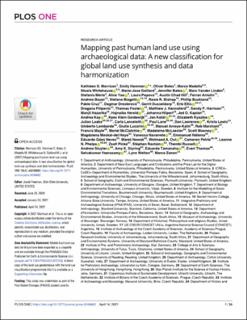| dc.contributor.author | Morrison, Kathleen D. | |
| dc.contributor.author | Hammer, Emily | |
| dc.contributor.author | Boles, Oliver | |
| dc.contributor.author | Madella, Marco | |
| dc.contributor.author | Whitehouse, Nicola | |
| dc.contributor.author | Gaillard, Marie-Jose | |
| dc.contributor.author | Bates, Jennifer | |
| dc.contributor.author | Vander Linden, Marc | |
| dc.contributor.author | Merlo, Stefania | |
| dc.contributor.author | Yao, Alice | |
| dc.contributor.author | Popova, Laura | |
| dc.contributor.author | Hill, Austin Chad | |
| dc.contributor.author | Antolin, Ferran | |
| dc.contributor.author | Bauer, Andrew | |
| dc.contributor.author | Biagetti, Stefano | |
| dc.contributor.author | Bishop, Rosie Rhiannon | |
| dc.contributor.author | Buckland, Phillip | |
| dc.contributor.author | Cruz, Pablo | |
| dc.contributor.author | Dreslerová, Dagmar | |
| dc.contributor.author | Dusseldorp, Gerrit | |
| dc.contributor.author | Ellis, Erle | |
| dc.contributor.author | Filipovic, Dragana | |
| dc.contributor.author | Foster, Thomas | |
| dc.contributor.author | Hannaford, Matthew J. | |
| dc.contributor.author | Harrison, Sandy P. | |
| dc.contributor.author | Hazarika, Manjil | |
| dc.contributor.author | Herold, Hajnalka | |
| dc.contributor.author | Hilpert, Johanna | |
| dc.contributor.author | Kaplan, Jed O. | |
| dc.contributor.author | Kay, Andrea | |
| dc.contributor.author | Klein Goldewijk, Kees | |
| dc.contributor.author | Kolář, Jan | |
| dc.contributor.author | Kyazike, Elizabeth | |
| dc.contributor.author | Laabs, Julian | |
| dc.contributor.author | Lancelotti, Carla | |
| dc.contributor.author | Lane, Paul | |
| dc.contributor.author | Lawrence, Dan | |
| dc.contributor.author | Lewis, Krista | |
| dc.contributor.author | Lombardo, Umberto | |
| dc.contributor.author | Lucarini, Giulio | |
| dc.contributor.author | Arroyo-Kalin, Manuel | |
| dc.contributor.author | Marchant, Rob | |
| dc.contributor.author | Mayle, Francis | |
| dc.contributor.author | McClatchie, Meriel | |
| dc.contributor.author | McLeester, Madeleine | |
| dc.contributor.author | Mooney, Scott | |
| dc.contributor.author | Moskal-del Hoyo, Magdalena | |
| dc.contributor.author | Navarrete, Vanessa | |
| dc.contributor.author | Ndiema, Emmanuel | |
| dc.contributor.author | Góes Neves, Eduardo | |
| dc.contributor.author | Nowak, Marek | |
| dc.contributor.author | Out, Welmoed A. | |
| dc.contributor.author | Petrie, Cameron | |
| dc.contributor.author | Phelps, Leanne N. | |
| dc.contributor.author | Pinke, Zsolt | |
| dc.contributor.author | Rostain, Stéphen | |
| dc.contributor.author | Russell, Thembi | |
| dc.contributor.author | Sluyter, Andrew | |
| dc.contributor.author | Styring, Amy K. | |
| dc.contributor.author | Tamanaha, Eduardo | |
| dc.contributor.author | Thomas, Evert | |
| dc.contributor.author | Veerasamy, Selvakumar | |
| dc.contributor.author | Welton, Lynn | |
| dc.contributor.author | Zanon, Marco | |
| dc.date.accessioned | 2023-02-22T12:27:19Z | |
| dc.date.available | 2023-02-22T12:27:19Z | |
| dc.date.created | 2021-04-17T02:03:02Z | |
| dc.date.issued | 2021 | |
| dc.identifier.citation | Morrison, K. D., Hammer, E., Boles, O., Madella, M., Whitehouse, N., Gaillard, M. J., ... & Zanon, M. (2021). Mapping past human land use using archaeological data: A new classification for global land use synthesis and data harmonization. PLoS One, 16(4), e0246662. | en_US |
| dc.identifier.issn | 1932-6203 | |
| dc.identifier.uri | https://hdl.handle.net/11250/3053280 | |
| dc.description.abstract | In the 12,000 years preceding the Industrial Revolution, human activities led to significant changes in land cover, plant and animal distributions, surface hydrology, and biochemical cycles. Earth system models suggest that this anthropogenic land cover change influenced regional and global climate. However, the representation of past land use in earth system models is currently oversimplified. As a result, there are large uncertainties in the current understanding of the past and current state of the earth system. In order to improve repre- sentation of the variety and scale of impacts that past land use had on the earth system, a global effort is underway to aggregate and synthesize archaeological and historical evi- dence of land use systems. Here we present a simple, hierarchical classification of land use systems designed to be used with archaeological and historical data at a global scale and a schema of codes that identify land use practices common to a range of systems, both imple- mented in a geospatial database. The classification scheme and database resulted from an extensive process of consultation with researchers worldwide. Our scheme is designed to deliver consistent, empirically robust data for the improvement of land use models, while simultaneously allowing for a comparative, detailed mapping of land use relevant to the needs of historical scholars. To illustrate the benefits of the classification scheme and meth- ods for mapping historical land use, we apply it to Mesopotamia and Arabia at 6 kya (c. 4000 BCE). The scheme will be used to describe land use by the Past Global Changes (PAGES) LandCover6k working group, an international project comprised of archaeologists, historians, geographers, paleoecologists, and modelers. Beyond this, the scheme has a wide utility for creating a common language between research and policy communities, link- ing archaeologists with climate modelers, biodiversity conservation workers and initiatives. | en_US |
| dc.language.iso | eng | en_US |
| dc.publisher | PLOS | en_US |
| dc.rights | Navngivelse 4.0 Internasjonal | * |
| dc.rights.uri | http://creativecommons.org/licenses/by/4.0/deed.no | * |
| dc.title | Mapping past human land use using archaeological data: A new classification for global land use synthesis and data harmonization | en_US |
| dc.type | Peer reviewed | en_US |
| dc.type | Journal article | en_US |
| dc.description.version | publishedVersion | en_US |
| dc.rights.holder | The authors | en_US |
| dc.subject.nsi | VDP::Humaniora: 000::Arkeologi: 090 | en_US |
| dc.source.volume | 16 | en_US |
| dc.source.journal | PLOS ONE | en_US |
| dc.source.issue | 4 | en_US |
| dc.identifier.doi | 10.1371/journal.pone.0246662 | |
| dc.identifier.cristin | 1904722 | |
| cristin.ispublished | true | |
| cristin.fulltext | original | |
| cristin.qualitycode | 1 | |

